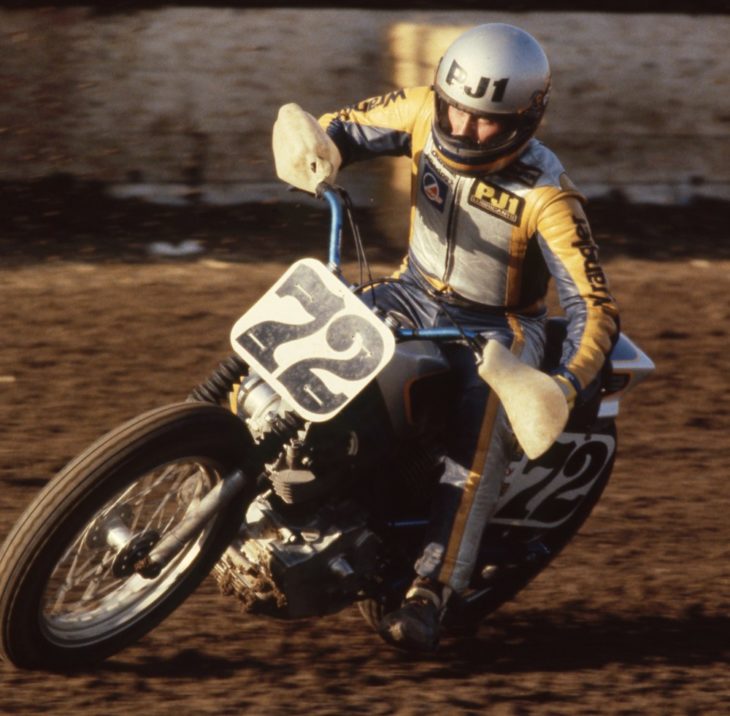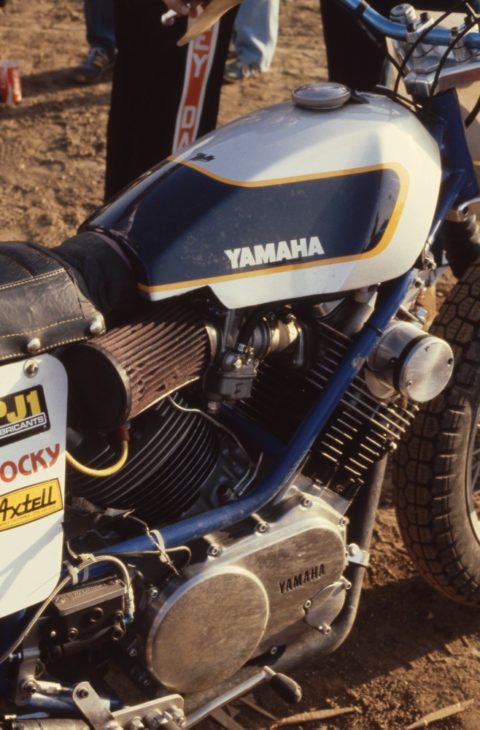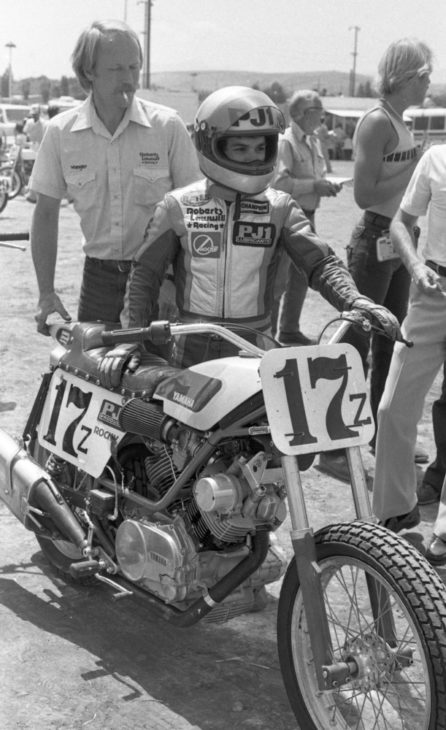Larry Lawrence | September 12, 2018
Archives: Yamaha’s V-Twin Flat Tracker
In 1981 an impressive group of racing and tuning talent banded together, with Yamaha factory backing, and built a Virago XV750-based flat track racing machine. The effort, inspired initially by the wishes of Yamaha dealerships across the country wanting to see Kenny Roberts back in AMA Grand National competition, was headed by racing legends Kenny Roberts and Mert Lawwill and backed by a vastly experienced crew that included Dick Mann, Bud Aksland, Mike Libby and C.R. Axtell. A hoped side benefit of the Yamaha XV dirt track project was making the engine available to privateer teams for under $2000, this at a time when it cost $5000 for an XR750 motor. Yamaha shipped in 75 motors for just that purpose, yet for all the promise the XV project held it ultimately was abandoned after two years of development by some of the best in the business.
Archives: Yamaha’s V-Twin Flat Tracker
 Mike Kidd on Yamaha’s XV750. In 1981 Kidd was a factory Yamaha rider and won that’s year’s AMA Grand National Championship. He raced Yamahas in Short Track and TT Nationals, but on the big tracks Kidd raced a Harley-Davidson. That likely made Kidd one of the only riders in AMA racing history who was paid by one factory, yet raced another brand most of the time.
Mike Kidd on Yamaha’s XV750. In 1981 Kidd was a factory Yamaha rider and won that’s year’s AMA Grand National Championship. He raced Yamahas in Short Track and TT Nationals, but on the big tracks Kidd raced a Harley-Davidson. That likely made Kidd one of the only riders in AMA racing history who was paid by one factory, yet raced another brand most of the time.
In 1981 when the XV project came to fruition, Kenny Roberts was primarily still focused on winning the FIM 500cc Motorcycle Grand Prix Championship. That meant Lawwill was doing the bulk of the overall development work on the XV, Lawwill and Mann were working on cradle frame and suspension while Axtell was on the dyno trying to coax a wide and strong powerband from the Yamaha V-Twin. Handling the riding chores on the prototype Yamaha XV750s were Yamaha factory contracted riders, veteran Mike Kidd and up-and-coming rookie expert Jimmy Filice.
The XV750 was Japan’s version of the American XV920. In the U.S. the bikes were shaft driven, but in Japan, both shaft and chain-driven versions were available. Modifications to the XV to make it ready for racing included an aluminum left side cover that helped narrow the engine width. That also meant moving the ignition and alternator. Since the XV’s stock crank was overbuilt to handle the power of a 920 and even 980cc version (sold in Europe) the crankshaft and lower were deemed strong enough for racing the 750cc version. The XV flat tracker used two 38mm Dell ‘Orto carbs. One issue with the XV motor for racing was the rear cylinder exhaust exited the back of the head, meaning the pipe had to be bent and shoe-horned between the gearbox and swingarm. The routing blocked airflow and also meant the rear cylinder ran considerably hotter than the front requiring the rear cylinder to use a different cam than the front. The front camshaft drove the repositioned ignition. Both cylinders had dedicated points and coil.
Horsepower was rumored to be in the same ballpark as an XR750, which at the time was 80 horsepower give or take. Lawwill said the XV engine could conservatively go 100 race miles between rebuilds.
 A close-up view of the Yamaha XV750’s powerplant. The engine ran backwards compared to most V-Twins and that caused handling issues.
A close-up view of the Yamaha XV750’s powerplant. The engine ran backwards compared to most V-Twins and that caused handling issues.
One oddity with the XV was that the engine ran backwards, meaning the crank spun in the opposite direction of the wheels. Lawwill and crew initially dismissed the effect this would have on handling, but Kidd said he felt the backwards spinning motor caused the bike to stand up in the turns.
“When you were sitting in the pits with the engine running on a Harley, you could rev it up and you could feel the bike squat,” Kidd explained. “It did the same thing on the track. You’d accelerate out of a turn and the thing would just squat and hook up. On the Yamaha it would just never squat. It just never seemed to settle coming out of the turns and would still be sliding out towards the wall when everyone else was on the gas and squirting away.”
While the Yamaha was being developed, Kidd was allowed to ride one of Lawwill’s Harley’s on the big tracks. That put Kidd in the unique position of probably being the only rider in history being paid by Yamaha, but racing a Harley in competition.
“Coming into the ’81 season I was fully committed to the Yamaha project,” Kidd explained. “And at the start of the season I raced Yamaha short track bikes at Houston and then won at Ascot. Then I started doing well on Mert’s Harley and before you know it, I was in the hunt for the championship.”
Kidd battling for the ’81 AMA Grand National No. 1 plate may have proved to be a downfall for the XV project. Suddenly with the opportunity to win his first national championship, Kidd’s priorities changed.
“All of a sudden in my eyes, developing the XV took a back seat to me winning the number one,” Kidd explained.
Kidd only tried to practice and qualify with the Yamaha a couple more times in the second half of the season, switching to the Harley on the big tracks as he raced to victory in the 1981 championship in a furious battle with Gary Scott and Randy Goss.
 Talented rookie expert Jimmy Filice did much of the development on the Yamaha XV750. He came close a couple of times of putting the bike in the main event of a national.
Talented rookie expert Jimmy Filice did much of the development on the Yamaha XV750. He came close a couple of times of putting the bike in the main event of a national.
Filice was the sole rider for the XV750 project in ’82, Kidd signing with Honda and taking the No. 1 plate with him. The closest Filice ever came to making a national on the XV was at the ’82 Sacramento Mile. He was leading the Last-Chance Qualifier on the final lap, when he tangled with Jay Beach in the first turn and got shuffled back to fourth.
The program gradually fizzled out that summer just as the team was finding more power, only to have it blow up several times under the strain. Filice crashed and broke his wrist at the July Indy Mile, forcing him to miss much of the rest of the season. By then his road racing prowess was coming into the forefront and his focus too began to shift towards a future on the pavement.
Steve Morehead tested the Yamaha at Du Quoin and was offered a ride on the bike, but declined. Ricky Campbell raced the bike at the August Indy Mile and came within one position in his Semi of making the Main.
With the industry suffering a recession, budgets were being shaved back and at the end of the 1982 season Yamaha pulled the plug on the XV750 project.
“It was a shame that they didn’t keep working to develop that bike,” Kidd concluded. “I felt a little bad for the way things turned out when I suddenly found myself with the championship in reach. Who knows? If I hadn’t been in the hunt for the number one maybe we could have really put more focus on the Yamaha and made it into a winning bike. It had a lot of potential and we had all the right people in place to make it work – it just needed a little more time.”
You can read more about the Yamaha XV750 program and much more by subscribing to the Cycle News Archives at: https://www.cyclenews.com/cycle-news-archives/